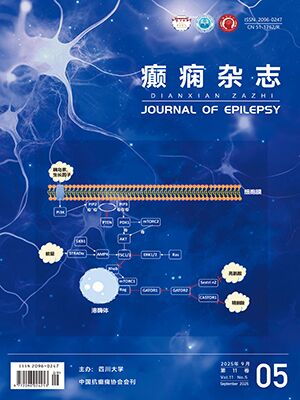| 1. |
Hupalo M, Wojcik R, Jaskolski DJ, et al. Intracranial video-EEG monitoring in presurgical evaluation of patients with refractory epilepsy. Neurol Neurochir Pol, 2017, 51(3): 201-207.
|
| 2. |
Katz JS, Abel TJ. Stereoelectroencephalography versus subdural electrodes for localization of the epileptogenic zone: what is the evidence? Neurotherapeutics, 2019, 16(1): 59-66.
|
| 3. |
Gonzalez-Martinez J, Najm IM. Indications and selection criteria for invasive monit-oring in children with cortical dysplasia. Childs Nerv Syst, 2014, 30(11): 1823-1829.
|
| 4. |
Joswig H, Steven DA, Parrent AG, et al. Intracranial electroencephalographic monitoring: from subdural to depth electrodes. Can J Neurol Sci, 2018, 45(3): 336-338.
|
| 5. |
Kovac S, Vakharia VN, Scott C, et al. Invasive epilepsy surgery evaluation. Seizure, 2017, 44: 125-136.
|
| 6. |
Enatsu R, Bulacio J, Najm I, et al. Combining stereo-electroencephalography and subdural electrodes in the diagnosis and treatment of medically intractable epilepsy. J Clin Neurosci, 2014, 21(8): 1441-1445.
|
| 7. |
Podkorytova I, Hoes K, Lega B, et al. Stereoencephalography versus subdural electrodes for seizure localization. Neurosurg Clin N Am, 2016, 27(1): 97-109.
|
| 8. |
Engel J Jr. Update on surgical treatment of the epilepsies. Summary of the Second International Palm Desert Conference on the Surgical Treatment of the Epilepsies (1992). Neurology, 1993, 43(8): 1612-1617.
|
| 9. |
Ramantani G, Maillard L, Koessler L, et al. Correlation of invasive EEG and scalp EEG. Seizure, 2016, 41: 196-200.
|
| 10. |
Yang M, Ma Y, Li W, et al. A Retrospective analysis of stereoelectroencephalo-graphy and subdural electroencephalography for preoperative evaluation of intractable epilepsy. Stereotact Funct Neurosurg, 2017, 95(1): 13-20.
|
| 11. |
Minotti L, Montavont A, Scholly J, et al. Indications and limits of stereoelectroence-phalography (SEEG). Neurophysiol Clin, 2018, 48(1): 15-24.
|
| 12. |
Fujimoto A, Okanishi T, Kanai S, et al. Neuronavigation-guided frameless stereoelectroencephalography (SEEG). Neurol Med Chir (Tokyo), 2017, 57(9): 496-502.
|
| 13. |
Ollivier I, Behr C, Cebula H, et al. Efficacy and safety in frameless robot-assisted stereo-electroencephalography (SEEG) for drug-resistant epilepsy. Neurochirurgie, 2017, 63(4): 286-290.
|
| 14. |
Candela-Cantá S, Aparicio J, Lápez JM, et al. Frameless robot-assisted stereo-electroencephalography for refractory epilepsy in pediatric patients: accuracy, usefulness, and technical issues. Acta Neurochir (Wien), 2018, 160(12): 2489-2500.
|
| 15. |
Enatsu R, Mikuni N. Invasive evaluations for epilepsy surgery: a review of the literature. Neurol Med Chir (Tokyo), 2016, 56(5): 221-227.
|
| 16. |
Fountas KN, Smith JR. Subdural electrode-associated complications: a 20-year experience. Stereotact Funct Neurosurg, 2007, 85(6): 264-272.
|
| 17. |
Arya R, Mangano FT, Horn PS, et al. Adverse events related to extraoperative invasive EEG monitoring with subdural grid electrodes: a systematic review and meta-analysis. Epilepsia, 2013, 54(5): 828-839.
|
| 18. |
Nair DR, Burgess R, McIntyre CC, et al. Chronic subdural electrodes in the management of epilepsy. Clin Neurophysiol, 2008, 119(1): 11-28.
|
| 19. |
Lee WS, Lee JK, Lee SA, et al. Complications and results of subdural grid electrode implantation in epilepsy surgery. Surg Neurol, 2000, 54(5): 346-351.
|
| 20. |
Mullin JP, Shriver M, Alomar S, et al. Is SEEG safe? A systematic review and meta-analysis of stereoelectroencephalography related complications. Epilepsia, 2016, 57(3): 386-401.
|
| 21. |
Sacino MF, Huang SS, Schreiber J, et al. Is the use of Stereotactic electroencephalography safe and effective in children? A Meta-analysis of the use of stereotactic electroencephalography in comparison to subdural grids for invasive epilepsy monitoring in pediatric subjects. Neurosurgery, 2018, 22(1): 1-11.
|
| 22. |
Ho AL, Muftuoglu Y, Pendharkar AV, et al. Robot-guided pediatric stereoelectroencephalography: single-institution experience. J Neurosurg Pediatr, 2018, 22(5): 1-8.
|




